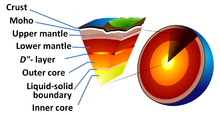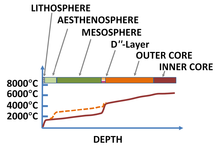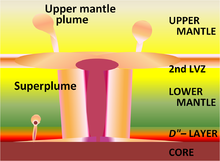- Mantle convection
-
An oceanic plate of the lithosphere is added to by upwelling asthenosphere at a spreading ridge (left) and consumed at a subduction zone (right), causing stratovolcanoes at the convergent boundary with the continental plate.
 Calculated Earth's temperature vs. depth. Dashed curve: Layered mantle convection; Solid curve: Whole mantle convection.[1]
Calculated Earth's temperature vs. depth. Dashed curve: Layered mantle convection; Solid curve: Whole mantle convection.[1] A superplume generated by cooling processes in the mantle.[2]
A superplume generated by cooling processes in the mantle.[2]
Mantle convection is the slow creeping motion of Earth's rocky mantle caused by convection currents carrying heat from the interior of the Earth to the surface.[3] The Earth's surface lithosphere, which rides atop the asthenosphere (the two components of the upper mantle), is divided into a number of plates that are continuously being created and consumed at their opposite plate boundaries. Accretion occurs as mantle is added to the growing edges of a plate, usually associated with seafloor spreading. This hot added material cools down by conduction and convection of heat. At the consumption edges of the plate, the material has thermally contracted to become dense, and it sinks under its own weight in the process of subduction at an ocean trench.[4]
This subducted material sinks to a depth of 660 kilometers in the Earth's interior where it is impeded from sinking further, possibly due to a phase change from spinel to perovskite and magnesiowustite, an endothermic reaction.[5]
The subducted oceanic crust triggers volcanism, although the basic mechanisms are varied. Volcanism may occur due to processes that add buoyancy to partially melted mantle causing an upward flow due to a decrease in density of the partial melt.
Secondary forms of convection that may result in surface volcanism are postulated to occur as a consequence of intraplate extension[6] and mantle plumes.[1]
It is because the mantle can convect that the tectonic plates are able to move around the Earth's surface.[7]
Contents
Types of convection
There is a current debate within the geophysics community as to whether convection is likely to be 'layered' or 'whole'.[8] This debate is linked to the controversy regarding whether intraplate volcanism is caused by shallow, upper-mantle processes or by plumes from the lower mantle.[6] Geochemists have argued that the lavas erupted in intraplate areas are different in composition from shallow-derived mid ocean ridge basalts (MORB). This has been interpreted as their originating from a different region, suggested to be the lower mantle. Others, however, have pointed out that the differences indicate the inclusion of a small component of near-surface material from the lithosphere. Seismologists are also divided, with some arguing that there is no evidence for whole-mantle convection[9], and others arguing that there is.[10]
Speed of convection
Typical mantle convection speed is 20 mm./yr near the crust but can vary quite a bit.[11] [12] [13] The small scale convection in the upper mantle is much faster than the convection near the core. (See whole-mantle discussion above.) A single shallow convection cycle takes on the order of 50 Million Years, though deeper convection can be closer to 200 Million Years.[14]
See also
References
- ^ a b Kent C. Condie (1997). Plate tectonics and crustal evolution (4th ed.). Butterworth-Heinemann. p. 5. ISBN 0-7506-3386-7. http://books.google.com/books?id=HZrA6OQzsvgC&pg=PA5.
- ^ Ctirad Matyska & David A Yuen (2007). "Figure 17 in Lower-mantle material properties and convection models of multiscale plumes". Plates, plumes, and planetary processes. Geological Society of America. p. 159. ISBN 0-8137-2430-9. http://books.google.com/books?id=l9a7tIJBYbkC&pg=PA159.
- ^ Kobes, Randy and Kunstatter, Gabor."Mantle Convection". Physics Department, University of Winnipeg. Retrieved 3 January 2010.
- ^ Gerald Schubert, Donald Lawson Turcotte, Peter Olson (2001). "Chapter 2: Plate tectonics". Mantle convection in the earth and planets. Cambridge University Press. p. 16 ff. ISBN 0-521-79836-1. http://books.google.com/books?id=ij4BaFFpYHAC&pg=PA16.
- ^ Gerald Schubert, Donald Lawson Turcotte, Peter Olson. "§2.5.3: Fate of descending slabs". Cited work. p. 35 ff. ISBN 0-521-79836-1. http://books.google.com/books?id=ij4BaFFpYHAC&pg=PA35.
- ^ a b Foulger, G.R. (2010). Plates vs. Plumes: A Geological Controversy. Wiley-Blackwell. ISBN 978-1-4051-6148-0. http://www.wiley.com/WileyCDA/WileyTitle/productCd-1405161485.html.
- ^ Moresi, Louis; Solomatov, Viatcheslav (1998). "Mantle convection with a brittle lithosphere: thoughts on the global tectonic styles of the Earth and Venus". Geophysical Journal International 133: 669. Bibcode 1998GeoJI.133..669M. doi:10.1046/j.1365-246X.1998.00521.x. http://citeseerx.ist.psu.edu/viewdoc/download?doi=10.1.1.30.5989&rep=rep1&type=pdf.
- ^ See for example, Donald Lawson Turcotte, Gerald Schubert (2002). Geodynamics (2nd ed.). Cambridge University Press. ISBN 0-521-66624-4. http://books.google.com/books?id=-nCHlVuJ4FoC&pg=PA286.; and also: Gerald Schubert, Donald Lawson Turcotte, Peter Olson (2001). Cited work. p. 616. ISBN 0-521-79836-1. http://books.google.com/books?id=ij4BaFFpYHAC&pg=PA616.
- ^ Ritsema, J; Van Heijst, HJ; Woodhouse, JH (1999). "Complex shear wave velocity structure imaged beneath Africa and Iceland". Science 286 (5446): 1925–1928. doi:10.1126/science.286.5446.1925. PMID 10583949.
- ^ Montelli, R; Nolet, G; Dahlen, FA; Masters, G; Engdahl ER, Hung SH (2004). "Finite-frequency tomography reveals a variety of plumes in the mantle". Science 303 (5656): 338–43. Bibcode 2004Sci...303..338M. doi:10.1126/science.1092485. PMID 14657505.
- ^ Small-scale convection in the upper mantle beneaththe Chinese Tian Shan Mountains, http://www.vlab.msi.umn.edu/reports/allpublications/files/2007-pap79.pdf
- ^ Polar Wandering and Mantle Convection, http://articles.adsabs.harvard.edu/cgi-bin/nph-iarticle_query?bibcode=1972IAUS...48..212T&db_key=AST&page_ind=0&data_type=GIF&type=SCREEN_VIEW&classic=YES
- ^ Picture showing convection with velocities indicated. http://www.iris.edu/hq/gallery/photo/4344
- ^ Thermal Convection with a Freely Moving Top Boundary, See section IV Discussion and Conclusions http://physics.nyu.edu/jz11/publications/ConvecA.pdf
Geophysics Overview Subfields Geophysical fluid dynamics · Geodesy · Geodynamics · Geomagnetism · Mathematical geophysics · Mineral physics · Near-surface geophysics · Paleomagnetism · Seismology · TectonophysicsPhysical Phenomena Coriolis effect · Earth's magnetic field · Geodynamo · Geothermal gradient · Gravity of Earth · Mantle convection · Seismic waveOrganizations American Geophysical Union · Canadian Geophysical Union · Environmental and Engineering Geophysical Society · European Geosciences Union · International Union of Geodesy and Geophysics · Royal Astronomical Society · Society of Exploration Geophysicists · Seismological Society of AmericaCategories:
Wikimedia Foundation. 2010.





